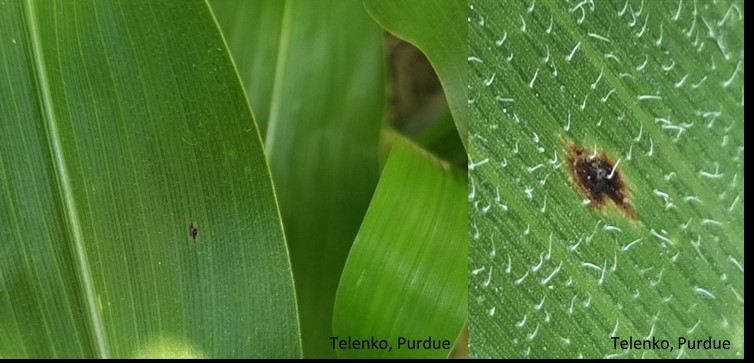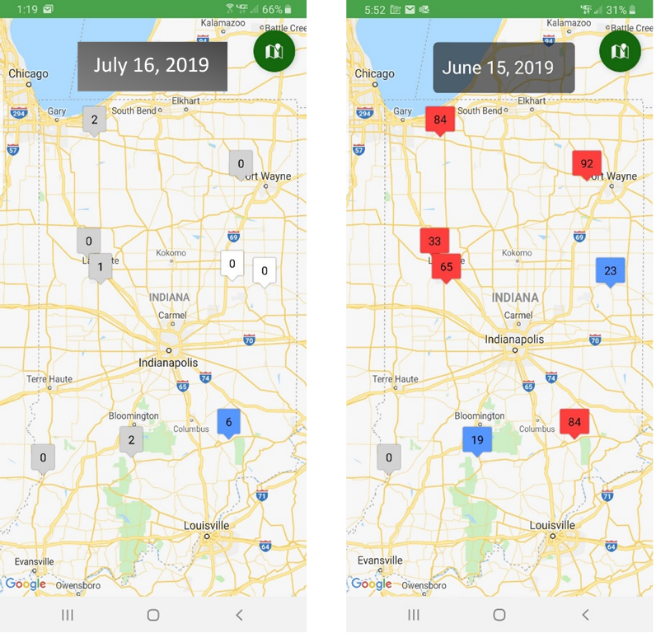It is time to get out and scout for corn diseases. Even though recent weather conditions have been hot and dry, there are a number of corn diseases emerging in the lower canopy. We have confirmed both tar spot and southern rust this week in Indiana as some fields are starting to tassel (VT). The most frequent question I have received is, “Should we make a fungicide application?” My response – What diseases are you finding in your field? What is your hybrid susceptibility and field history? What growth stage? Are you irrigating?
A fungicide application can be effective at reducing disease and protecting yield, but there are a number of factors that need to be considered: the field history/previous crop, the amount of disease present in the field, hybrid susceptibility, weather conditions, and the price of corn and cost of fungicide application.
Tar Spot: This disease is on everyone’s mind. The first confirmation in the Midwest occurred in Porter County, Indiana on July 12. Tar spot was identified at an extremely low incidence in this field. Since then I have found active tar spots in two other fields – one each in Porter and LaPorte Counties (see Figure 1).

Figure 1. 2019 Distribution map of counties confirmed for tar spot of corn in Indiana. Website: https://corn.ipmpipe.org
My observations at these sites:
- Field with history of severe tar spot in 2018
- Corn is at tassel (VT)
- Infection occurred at 4th or 5th leaf and only 1-2 spots were found on a leaf
- Two of the three confirmed sites are under irrigation
These initial findings are like finding a needle in the haystack and required intensive scouting. See image of the tar spots (Figure 2). Our current hot and dry weather is not conducive to tar spot – the infections we found most likely occurred back in mid-June with all the rain. In addition, we continue to have suspect reports that turned out to be insect frass. Please see last week’s article on how to distinguish between insect frass and tar spot (https://extension.entm.purdue.edu/newsletters/pestandcrop/article/an-update-on-corn-tar-spot-what-to-do-if-you-suspect-it-is-in-your-field/).

Figure 2. Tar spot lesion on corn in lower canopy. High resolution of the stroma formed on the leaf. (Photo Credit: Darcy Telenko)
We are working hard to try to understand this new disease to minimize losses, but still don’t have good information on optimum fungicide timing and efficacy for Indiana corn production – multiple trials are in place this year to try to address these questions. The current calculated tar spot risk based on the Tarspotter app for July 16, 2019, at multiples locations in Indiana, is generally low to none (Figure 3). The low risk is based on the hot and dry conditions we have seen across the state. This is compared the high risk back on June 15, 2019, when we had high moisture conditions. These conditions most likely led to the infections we have currently identified.
Due to the hot and dry weather, I would only consider a fungicide spray if a field met ALL four conditions listed below. I would also leave a test strip to evaluate effectiveness and benefit of the fungicide application.
- Field history of severe tar spot in 2018 and replanted to corn.
- Corn nearing VT (this is also the optimum timing for management of other foliar diseases when active such as gray leaf spot and northern corn leaf blight).
- Field is irrigated and receiving water weekly, and/or weather conditions change with lots of rain in the forecast.
- You find more than a few plants with tar spot when scouting a field.
Only if all four conditions are met, a fungicide application might be justified. Otherwise, I’m not recommending any action at this point in time. Again, this hot and dry weather is not conducive to tar spot – the infections we have found most likely occurred back mid-June.
Several fungicides are labelled to help manage tar spot. I would recommend picking a product with multiple modes of action. The national Corn Disease Working Group has developed a very useful fungicide efficacy table for corn diseases. It can be found at https://crop-protection-network.s3.amazonaws.com/publications/cpn-2011-corn-fungicide-efficacy-for-control-of-corn-diseases.pdf.
We will continue keeping a close eye on risk models and intensely scouting more fields. I am interested in adding more locations in surrounding counties in northern Indiana; please contact me if you are interested in helping.
If you suspect a field has tar spot please contact us and send a sample to the Purdue PPDL for confirmation.



